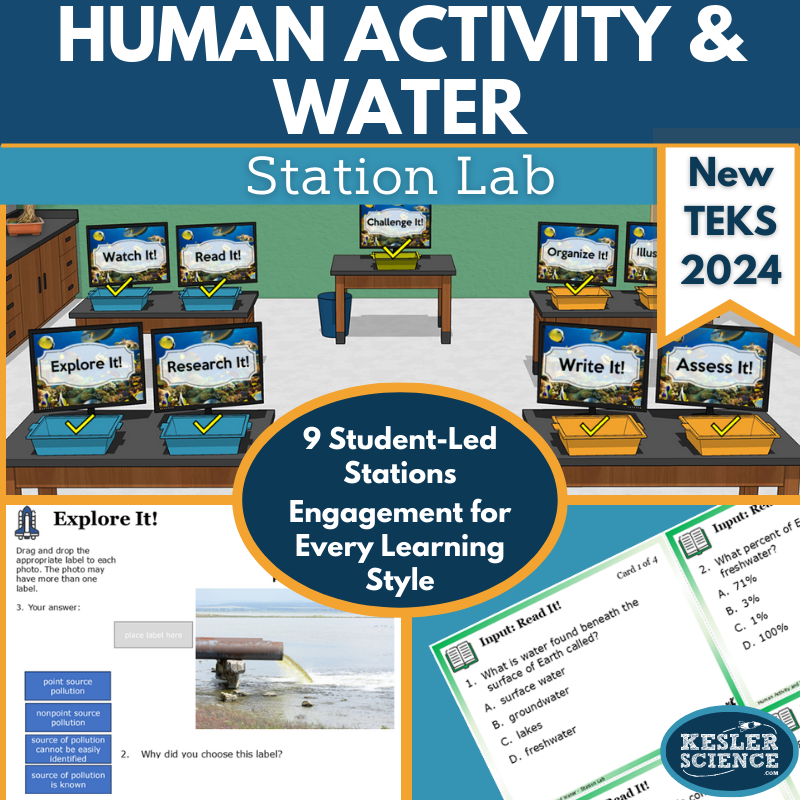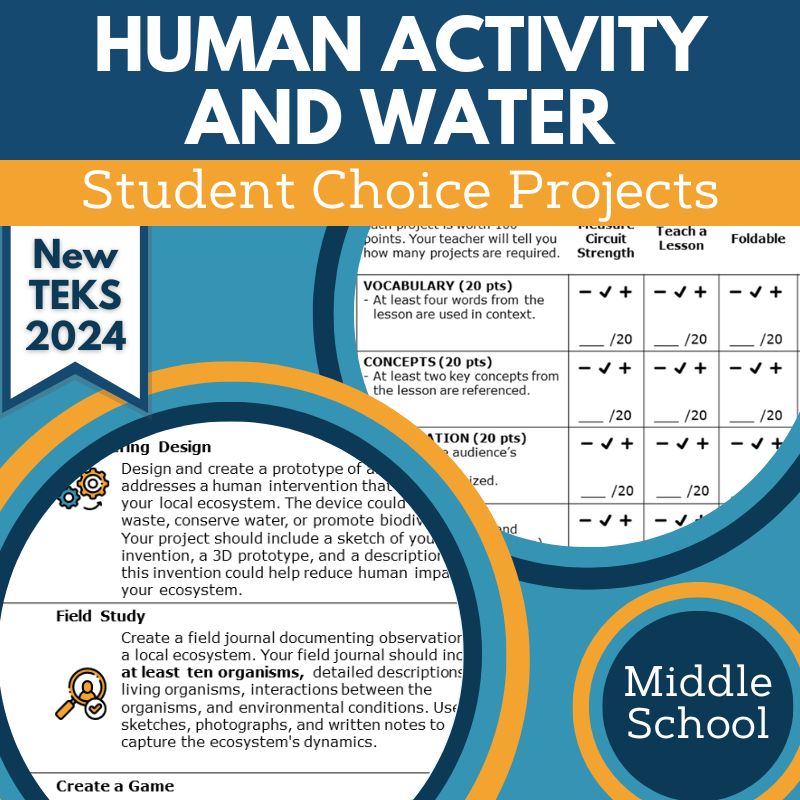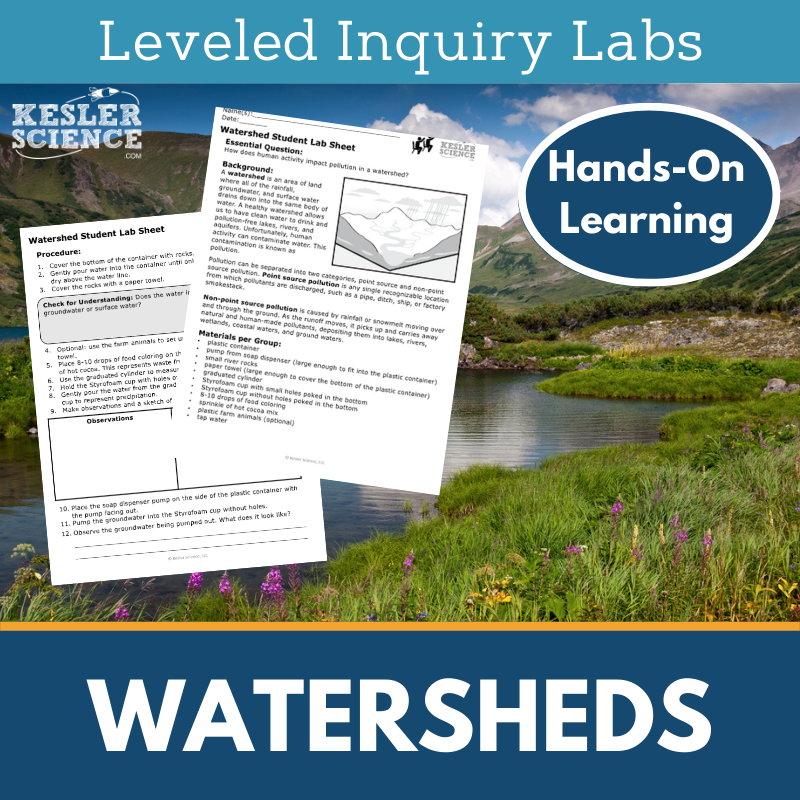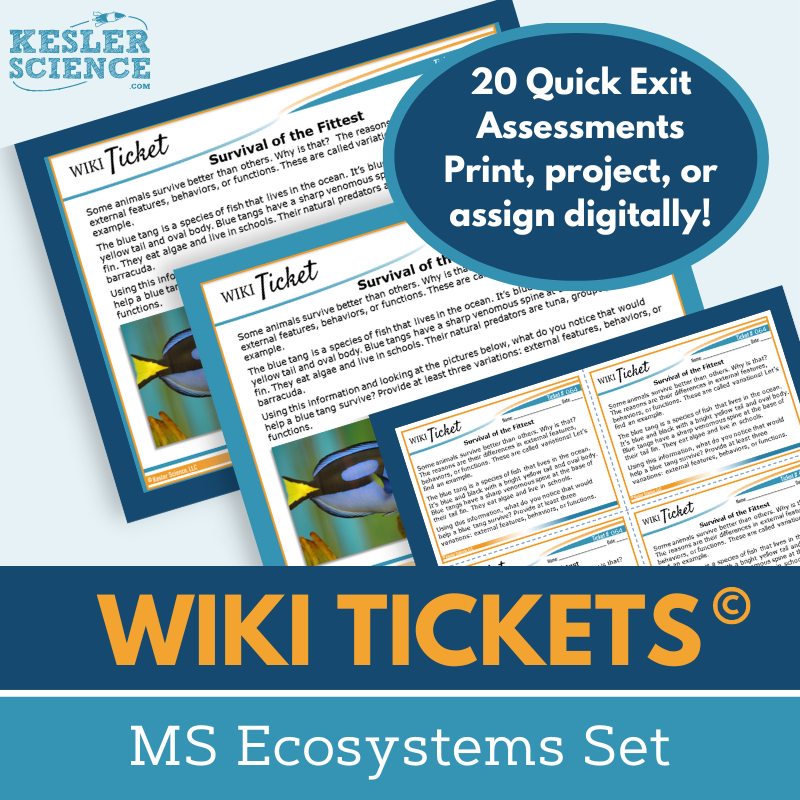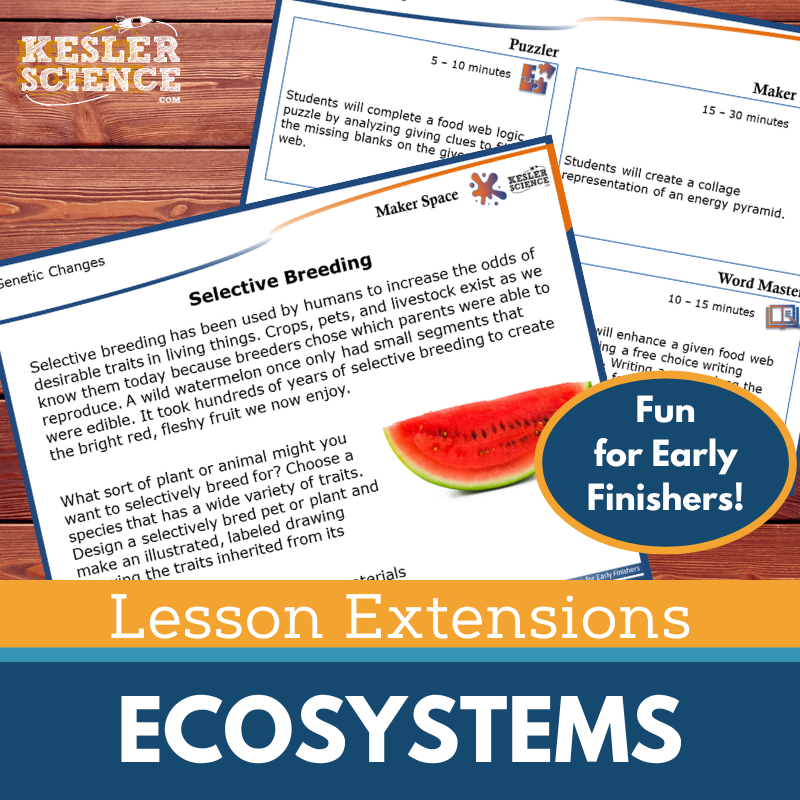Human Activity & Water Resources for Middle School Science
Explore the impact of human activity on groundwater and surface water with this engaging 5E lesson. The resources below will give students a comprehensive understanding of human activities on water. All of the following materials are also included in the Kesler Science Membership.
The Kesler Science Human Activity & Water 5E Lesson provides a comprehensive middle school unit on the impact of human activity on groundwater and surface water in a watershed. It includes editable presentations, worksheets, student-choice projects, and assessments designed for differentiated, student-led learning with minimal prep. The lesson aligns with the 2021 TEKS 7.11A standard and is available in both print and digital formats, with Spanish translations for key materials.
Following the 5E Model, the lesson begins with engagement activities, including objectives, word wall cards, and teacher-led discussions. During exploration, students engage in a hands-on, student-led station lab featuring nine stations that explore water conservation and pollution through experiments, reading passages, research, videos, and interactive activities. Explanation resources include editable PowerPoints, interactive notebooks, and note-taking templates. Students extend their learning through choice projects involving human impact on watersheds. Evaluation includes STAAR 2.0-aligned assessments, review questions, and worksheets suitable for class discussion or homework.
The lesson is designed for maximum flexibility, allowing students to engage in learning both in-class and virtually through interactive and differentiated resources.
The Kesler Science Human Activity & Water 5E Lesson provides a comprehensive middle school unit on the impact of human activity on groundwater and surface water in a watershed. It includes editable presentations, worksheets, student-choice projects, and assessments designed for differentiated, student-led learning with minimal prep. The lesson aligns with the 2021 TEKS 7.11A standard and is available in both print and digital formats, with Spanish translations for key materials.
Following the 5E Model, the lesson begins with engagement activities, including objectives, word wall cards, and teacher-led discussions. During exploration, students engage in a hands-on, student-led station lab featuring nine stations that explore water conservation and pollution through experiments, reading passages, research, videos, and interactive activities. Explanation resources include editable PowerPoints, interactive notebooks, and note-taking templates. Students extend their learning through choice projects involving human impact on watersheds. Evaluation includes STAAR 2.0-aligned assessments, review questions, and worksheets suitable for class discussion or homework.
The lesson is designed for maximum flexibility, allowing students to engage in learning both in-class and virtually through interactive and differentiated resources.
Engage your students with this student-led station lab aligned with TEKS 7.11A, exploring the impacts of human activity on groundwater and surface water in a watershed. Designed for in-class or virtual learning, this life science lesson encourages independent and small-group exploration through nine differentiated stations.
Students interact with new concepts through videos, readings, research, and hands-on activities, then demonstrate their understanding by organizing information, illustrating models, writing responses, and completing assessments. A bonus challenge station provides extension activities for advanced learners. English and Spanish reading passages support differentiated instruction. This low-prep, high-engagement resource promotes active learning and critical thinking.
Engage your students with this student-led station lab aligned with TEKS 7.11A, exploring the impacts of human activity on groundwater and surface water in a watershed. Designed for in-class or virtual learning, this life science lesson encourages independent and small-group exploration through nine differentiated stations.
Students interact with new concepts through videos, readings, research, and hands-on activities, then demonstrate their understanding by organizing information, illustrating models, writing responses, and completing assessments. A bonus challenge station provides extension activities for advanced learners. English and Spanish reading passages support differentiated instruction. This low-prep, high-engagement resource promotes active learning and critical thinking.
The Human Activity & Water Student Choice Projects align with the 2021 TEKS standard 7.11A, offering middle school students a variety of ways to demonstrate their understanding. A project page outlines six student-led options plus a “design your own” project, with an editable rubric for teacher, peer, or self-assessment.
These flexible, multimodal projects allow for creativity and personalization. Two versions of the project page support differentiation, with modified options for students needing remediation and challenge opportunities for advanced learners. Teachers can adjust the rubric to fit grading needs.
The projects require standard classroom supplies like paper, markers, and scissors, with many options available for digital completion.
The Human Activity & Water Student Choice Projects align with the 2021 TEKS standard 7.11A, offering middle school students a variety of ways to demonstrate their understanding. A project page outlines six student-led options plus a “design your own” project, with an editable rubric for teacher, peer, or self-assessment.
These flexible, multimodal projects allow for creativity and personalization. Two versions of the project page support differentiation, with modified options for students needing remediation and challenge opportunities for advanced learners. Teachers can adjust the rubric to fit grading needs.
The projects require standard classroom supplies like paper, markers, and scissors, with many options available for digital completion.
The Watershed Pollution Inquiry Lab aligns with TEKS, guiding students to model how livestock activity impacts surface and groundwater in a watershed. Using food coloring to represent pollutants, students observe how contaminants travel across surfaces and affect groundwater through a soap dispenser pump.
This resource includes three differentiated lab versions to support all learners: a dependent lab with guided inquiry, a modified lab with structured support, and an independent lab for advanced students to explore more freely. Editable teacher resource pages provide standards, objectives, materials, and instructions. CER conclusion prompts and reflection questions help students analyze their findings.
Students will use common materials, including plastic containers, river rocks, paper towels, Styrofoam cups, food coloring, and water, to create their models. Answer keys and teacher resources simplify planning, making this an engaging hands-on experience.
The Watershed Pollution Inquiry Lab aligns with TEKS, guiding students to model how livestock activity impacts surface and groundwater in a watershed. Using food coloring to represent pollutants, students observe how contaminants travel across surfaces and affect groundwater through a soap dispenser pump.
This resource includes three differentiated lab versions to support all learners: a dependent lab with guided inquiry, a modified lab with structured support, and an independent lab for advanced students to explore more freely. Editable teacher resource pages provide standards, objectives, materials, and instructions. CER conclusion prompts and reflection questions help students analyze their findings.
Students will use common materials, including plastic containers, river rocks, paper towels, Styrofoam cups, food coloring, and water, to create their models. Answer keys and teacher resources simplify planning, making this an engaging hands-on experience.
This Science Reading Comprehension Lesson explores the impact of human activities on ground and surface water through a nonfiction article about community water sources. Students answer comprehension questions and label and define parts of an aquifer to reinforce key concepts.
Designed for grades 6-8 (and advanced 5th graders), this resource includes two leveled articles (Lexile 1100-1300), five to seven comprehension questions, and a hands-on mini-project. A Cornell notes template is provided for structured learning, and the materials feature engaging visuals that print well in grayscale.
The resource is suitable for in-person and virtual learning, with files compatible with Google Classroom, MS Teams, Schoology, and Canvas. Students can complete activities directly in the provided PPT or Google Slides. Ideal for sub plans, ISS, extra credit, or whole-class instruction, this lesson promotes science literacy, textual analysis, and classroom discussions.
This Science Reading Comprehension Lesson explores the impact of human activities on ground and surface water through a nonfiction article about community water sources. Students answer comprehension questions and label and define parts of an aquifer to reinforce key concepts.
Designed for grades 6-8 (and advanced 5th graders), this resource includes two leveled articles (Lexile 1100-1300), five to seven comprehension questions, and a hands-on mini-project. A Cornell notes template is provided for structured learning, and the materials feature engaging visuals that print well in grayscale.
The resource is suitable for in-person and virtual learning, with files compatible with Google Classroom, MS Teams, Schoology, and Canvas. Students can complete activities directly in the provided PPT or Google Slides. Ideal for sub plans, ISS, extra credit, or whole-class instruction, this lesson promotes science literacy, textual analysis, and classroom discussions.
The Human Impact on Groundwater Science Writing Prompt Activity engages middle school students in a call-to-action writing exercise to explore the effects of human activity on groundwater and surface water in a watershed. Aligned with TEKS, this student-centered, low-prep activity enhances science reasoning and writing skills while supporting both in-person and virtual learning.
This resource includes teacher directions with an answer guide, project ideas, and rubrics, as well as projection and print handouts in both full-sized and half-sheet formats. A digital PowerPoint version, compatible with Google Slides, allows for seamless remote or interactive learning. It works well as a cross-curricular activity, pre-test assessment, student choice project, or enrichment for early finishers. Ideal for extra credit, make-up work, TELPAS samples, or differentiation, this writing prompt fosters engagement, creativity, and scientific literacy in any classroom.
The Human Impact on Groundwater Science Writing Prompt Activity engages middle school students in a call-to-action writing exercise to explore the effects of human activity on groundwater and surface water in a watershed. Aligned with TEKS, this student-centered, low-prep activity enhances science reasoning and writing skills while supporting both in-person and virtual learning.
This resource includes teacher directions with an answer guide, project ideas, and rubrics, as well as projection and print handouts in both full-sized and half-sheet formats. A digital PowerPoint version, compatible with Google Slides, allows for seamless remote or interactive learning. It works well as a cross-curricular activity, pre-test assessment, student choice project, or enrichment for early finishers. Ideal for extra credit, make-up work, TELPAS samples, or differentiation, this writing prompt fosters engagement, creativity, and scientific literacy in any classroom.
The WIKI Tickets© Ecosystems Set provides engaging, flexible formative assessments for 6th-8th grade science. This set includes 20 topics, each with five format options: a full-screen projection version, three printable handout sizes, and an interactive digital version compatible with PowerPoint and Google Slides.
Aligned with NGSS and TEKS standards, these assessments ensure comprehensive coverage, with each standard having at least one ticket. A bonus table of contents file is included to show standard alignment. Topics covered include biodiversity, ecological succession, food webs, natural selection, human impact on oceans, photosynthesis in ecosystems, and more.
Designed for both in-person and virtual learning, WIKI Tickets© can be used as exit tickets, bellringers, or quick checks. Students can respond on their own paper, printed handouts, or digitally in a 1:1 or remote setting. These colorful, engaging assessments help you gauge student understanding with ease.
The WIKI Tickets© Ecosystems Set provides engaging, flexible formative assessments for 6th-8th grade science. This set includes 20 topics, each with five format options: a full-screen projection version, three printable handout sizes, and an interactive digital version compatible with PowerPoint and Google Slides.
Aligned with NGSS and TEKS standards, these assessments ensure comprehensive coverage, with each standard having at least one ticket. A bonus table of contents file is included to show standard alignment. Topics covered include biodiversity, ecological succession, food webs, natural selection, human impact on oceans, photosynthesis in ecosystems, and more.
Designed for both in-person and virtual learning, WIKI Tickets© can be used as exit tickets, bellringers, or quick checks. Students can respond on their own paper, printed handouts, or digitally in a 1:1 or remote setting. These colorful, engaging assessments help you gauge student understanding with ease.
Lesson Extensions provide engaging, student-choice activities designed to challenge early finishers and deepen their understanding of ecosystem concepts. These activities help maintain focus, reinforce critical thinking, and provide rigorous yet enjoyable learning opportunities. Aligned with NGSS and TEKS standards, they support independent learning and enrichment in ecosystems.
Each extension includes four interactive components: Puzzler for problem-solving, Maker Space for hands-on STEAM activities, Tech Connection for digital demonstrations, and Word Master for creative writing. With teacher directions, answer keys, and both print and projection versions, these extensions are perfect for lesson wrap-ups, enrichment, or independent challenges.
Covering topics such as biodiversity, ecological succession, food webs, human impact, and photosynthesis, these activities offer high-level engagement that pushes students to explore ecosystems in depth.
Lesson Extensions provide engaging, student-choice activities designed to challenge early finishers and deepen their understanding of ecosystem concepts. These activities help maintain focus, reinforce critical thinking, and provide rigorous yet enjoyable learning opportunities. Aligned with NGSS and TEKS standards, they support independent learning and enrichment in ecosystems.
Each extension includes four interactive components: Puzzler for problem-solving, Maker Space for hands-on STEAM activities, Tech Connection for digital demonstrations, and Word Master for creative writing. With teacher directions, answer keys, and both print and projection versions, these extensions are perfect for lesson wrap-ups, enrichment, or independent challenges.
Covering topics such as biodiversity, ecological succession, food webs, human impact, and photosynthesis, these activities offer high-level engagement that pushes students to explore ecosystems in depth.
This Amazing Anchors Phenomenon Lesson introduces and reinforces watershed concepts through real-world connections. It includes an introductory reading centered on the Chesapeake Bay Foundation, with comprehension and extension questions to prepare students for further learning. An explanatory reading breaks down the impact of human activity on groundwater in an accessible way, followed by reinforcement questions to deepen understanding.
This no-prep resource includes teacher directions with answer keys, full-page projection slides, and both print and digital versions for Google Classroom and other LMS platforms. A modified version supports students with differentiated language and sentence starters. Designed to bookend a lesson, these engaging readings supplement any watershed-focused science lesson. Aligned with NGSS standard MS LS2-2, this resource provides flexible learning options for in-person and digital classrooms.
This Amazing Anchors Phenomenon Lesson introduces and reinforces watershed concepts through real-world connections. It includes an introductory reading centered on the Chesapeake Bay Foundation, with comprehension and extension questions to prepare students for further learning. An explanatory reading breaks down the impact of human activity on groundwater in an accessible way, followed by reinforcement questions to deepen understanding.
This no-prep resource includes teacher directions with answer keys, full-page projection slides, and both print and digital versions for Google Classroom and other LMS platforms. A modified version supports students with differentiated language and sentence starters. Designed to bookend a lesson, these engaging readings supplement any watershed-focused science lesson. Aligned with NGSS standard MS LS2-2, this resource provides flexible learning options for in-person and digital classrooms.
Year-Round Resources
These year-round activities will increase your students' understanding of many middle school science topics. All of these activities are also included in the Kesler Science Membership.
Visual Data & Graphing
You're not alone if your students struggle with understanding graphs, charts, and tables. It's a skill that takes an enormous amount of practice. This resource will help students build a strong foundation in analyzing data and creating their own data visualizations.
Bell Ringers and Warm-Ups
These middle school science bell ringers are an excellent way to engage your students as soon as they walk into your classroom. This comprehensive FULL YEAR resource includes everything you need to start off each science class with an interesting warm-up activity.
Review Board Games
Each game board has been carefully designed to keep students engaged. There are 10 different action spaces on each board and dozens of question cards. All of the actions are related to science concepts and keep the students motivated throughout the game.
Each game is ready to play. Simply print out the board and the cards and let the students enjoy reviewing nine different units.
Essential Questions and Standards
Below are the essential questions and standards associated with the lessons and activities included in the atoms unit. This topic is only one of more than 100 middle school science topics included in the Kesler Science Membership.
-
How can we analyze the influence of human activity on groundwater and surface water?
-
How can human activity both benefit and harm groundwater and surface water in a watershed?
-
TEKS Science - 7.11A Human Activity & Water
Kesler Science Membership
Imagine never having to search for another middle school science lesson again. The membership gives you access to ALL of the Kesler Science products in one place (Yes, including everything above).
Say goodbye to long hours of lesson prep.



